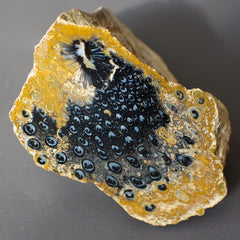August 29, 2013
Digging for Tasmanian Fossil Fern
Mosquitoes, midges, flies,funnel web spiders, leeches,wasps and tiger snakes. Just a part of the experience of searching for the elusive Lune river fossil plants. The prize awaits up to 6 foot down, through tough wet sticky clay, in a thin gravel layer of agates and fossils.
Fern is hard to find, but to find a good piece is much harder, many pieces have holes throughout or are totally black.
Easy NO rewarding YES.
The most beautiful plant fossils replaced by multi coloured agate are the reward, if you are lucky, but hard work does pay off !
These fossil tree ferns are from Lune River about 120kms south of Hobart, it is Australia's most southerly gem field. 165 million years ago the vegetation was flatterned by a pyroclastic flow from a nearby volcano, volcanic ash covered these plants. Then a 1km thick basalt and dolerite flow covered the plants, silica then replaced the carbon in the plant.
Perfectly preserved stems of wood, fern and cycad resulted. These fossils are amazing in their beauty and in their scientific preservation.
More than 13 species of tree fern, several cycads and different woods are found in this Jurassic graveyard. Dinosaur food!
Treasured in any rock hounds collection. The images are some pieces that The Rare and Beautiful have found. we have some for sale in the fossil category.

This beautiful specimen is osmundacaulis prushnikkii. The preservation is amazing with the structure of individual cells easily visible under magnification. Highly agatized with pyrite surrounding the "eyes" in the black section. Locally known as peacock fern due to its resemblance to a peacock tail.

This is a trunk section of osmundacaulis griggsii as it was found by The Rare and Beautiful.This specimen is too beautiful to cut and polish, and displays perfectly as is.

Bennettatalian cycadophyte stem perfectly preserved.
 Stem section of lunea Jonesii totally replaced by agate, a fossil and a gemstone in one specimen,very rare and highly desirable.Probably only one piece in a thousand is completely replaced by agate, the holy grail for fern diggers.
Stem section of lunea Jonesii totally replaced by agate, a fossil and a gemstone in one specimen,very rare and highly desirable.Probably only one piece in a thousand is completely replaced by agate, the holy grail for fern diggers.



 Stem section of lunea Jonesii totally replaced by agate, a fossil and a gemstone in one specimen,very rare and highly desirable.Probably only one piece in a thousand is completely replaced by agate, the holy grail for fern diggers.
Stem section of lunea Jonesii totally replaced by agate, a fossil and a gemstone in one specimen,very rare and highly desirable.Probably only one piece in a thousand is completely replaced by agate, the holy grail for fern diggers.